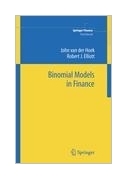|
||
podział tematyczny • wydawnictwa anglojęzyczne podział tematyczny Newsletter: • Zamów informacje o nowościach z wybranego tematu Informacje: • sposoby płatności i dostawy • kontakt • Cookies na stronie • Regulamin zakupów Napisz propresssp@gmail.com |
BINOMIAL MODELS IN FINANCEHOEK J., ELLIOT R.wydawnictwo: SPRINGER , rok wydania 2005, wydanie Icena netto: This book deals with many topics in modern financial mathematics in a way that does not
use advanced mathematical tools and shows how these models can be numerically implemented
in a practical way. The book is aimed at undergraduate students, MBA students, and
executives who wish to understand and apply financial models in the spreadsheet computing
environment. Contents: 1 Introduction 1.1 No Arbitrage and Its Consequences . 1.2 Exercises 2 The Binomial Model for Stock Options 2.1 The Basic Model . 2.2 Why Is ? Called a Risk Neutral Probability? . 2.3 More on Arbitrage 2.4 The Model of Cox-Ross-Rubinstein . 2.5 Call-Put Parity Formula 2.6 Non Arbitrage Inequalities 2.7 Exercises 3 The Binomial Model for Other Contracts 3.1 Forward Contracts 3.2 Contingent Premium Options 3.3 Exchange Rates 3.4 Interest Rate Derivatives . 3.5 Exercises . 4 Multiperiod Binomial Models . 4.1 The Labelling of the Nodes 4.2 The Labelling of the Processes 4.3 Generalized Quantities X Contents 4.4 Generalized Backward Induction Pricing Formula . 4.5 Pricing European Style Contingent Claims . 4.6 The CRR Multiperiod Model 4.7 Jamshidian’s Forward Induction Formula . 4.8 Application to CRR Model 4.9 The CRR Option Pricing Formula 4.10 Discussion of the CRR Formula 4.11 Exercises . 5 Hedging 5.1 Hedging . 5.2 Exercises . 6 Forward and Futures Contracts . 6.1 The Forward Contract . 6.2 The Futures Contract . 6.3 Exercises . 7 American and Exotic Option Pricing 7.1 American Style Options . 7.2 Barrier Options 7.3 Examples of the Application of Barrier Options 7.4 Exercises 8 Path-Dependent Options 8.1 Notation for Non-Recombing Trees . 8.2 Asian Options . 8.3 Floating Strike Options 8.4 Lookback Options . 8.5 More on Average Rate Options . 8.6 Exercises Contents XI 9 The Greeks 9.1 The Delta (?) of an Option 9.2 The Gamma (?) of an Option . 9.3 The Theta (?) of an Option . 9.4 The Vega (?) of an Option 9.5 The Rho (?) of an Option 9.6 Exercises . 10 Dividends . 10.1 Some Basic Results about Forwards 10.2 Dividends as Percentage of Spot Price 10.3 Binomial Trees with Known Dollar Dividends . 10.4 Exercises 11 Implied Volatility Trees 11.1 The Recursive Calculation 11.2 The Inputs V put and V call 11.3 A Simple Smile Example 11.4 In General . 11.5 The Barle and Cakici Approach . 11.6 Exercises 12 Implied Binomial Trees 12.1 The Inputs 12.2 Time T Risk-Neutral Probabilities . 12.3 Constructing the Binomial Tree 12.4 A Basic Theorem and Applications 12.5 Choosing Time T Data . 12.6 Some Proofs and Discussion 12.7 Jackwerth’s Extension . 12.8 Exercises XII Contents 13 Interest Rate Models . 13.1 P(0, T) from Treasury Data . 13.2 P(0, T) from Bank Data . 13.3 The Ho and Lee Model 13.4 The Pedersen, Shiu and Thorlacius Model . 13.5 The Morgan and Neave Model 13.6 The Black, Derman and Toy Model 13.7 Defaultable Bonds 13.8 Exercises 14 Real Options . 14.1 Examples 14.2 Options on Non-Tradeable Assets . 14.3 Correlation with Tradeable Assets 14.4 Approximate Methods . 14.5 Exercises A The Binomial Distribution A.1 Bernoulli Random Variables . A.2 Bernoulli Trials A.3 Binomial Distribution A.4 Central Limit Theorem (CLT) . A.5 Berry-Ess´een Theorem A.6 Complementary Binomials and Normals A.7 CRR and the Black and Scholes Formula . B An Application of Linear Programming . B.1 Incomplete Markets . B.2 Solutions to Incomplete Markets. . B.3 The Duality Theorem of Linear Programming . B.4 The First Fundamental Theorem of Finance . B.5 The Duality Theorem . B.6 The Second Fundamental Theorem of Finance . B.7 Transaction Costs Contents XIII C Volatility Estimation C.1 Historical Volatility Estimation . C.2 Implied Volatility Estimation C.3 Exercises . D Existence of a Solution . D.1 Farkas’ Lemma . D.2 An Application to the Problem . E Some Generalizations E.1 Preliminary Observations . E.2 Solution to System in van der Hoek’s Method E.3 Exercises F Yield Curves and Splines . F.1 An Alternative representation of Function (F.1) . F.2 Imposing Smoothness . F.3 Unknown Coe.cients F.4 Observations . F.5 Determination of Unknown Coe.cients . F.6 Forward Interest Rates F.7 Yield Curve F.8 Other Issues References . Index . 306 pages Hardcover Księgarnia nie działa. Nie odpowiadamy na pytania i nie realizujemy zamówien. Do odwolania !. |


